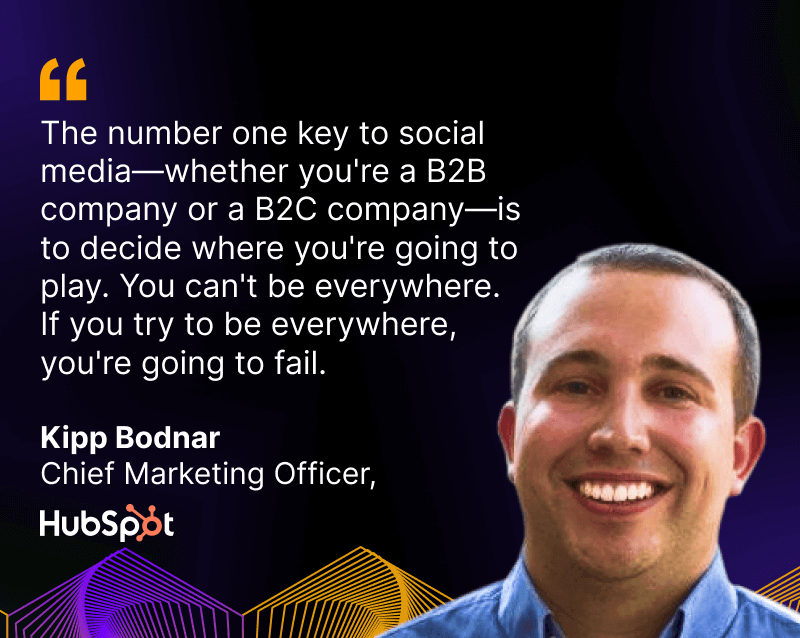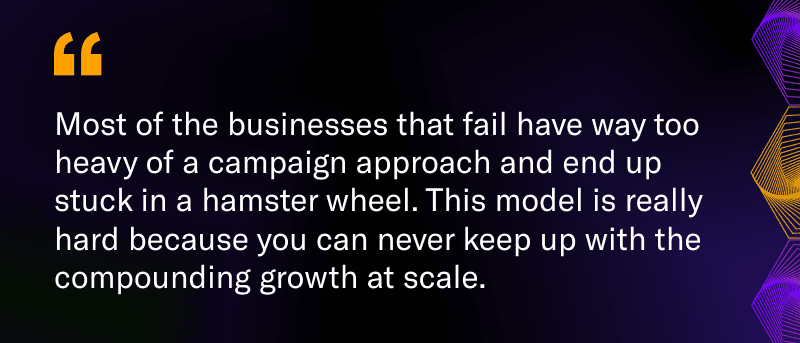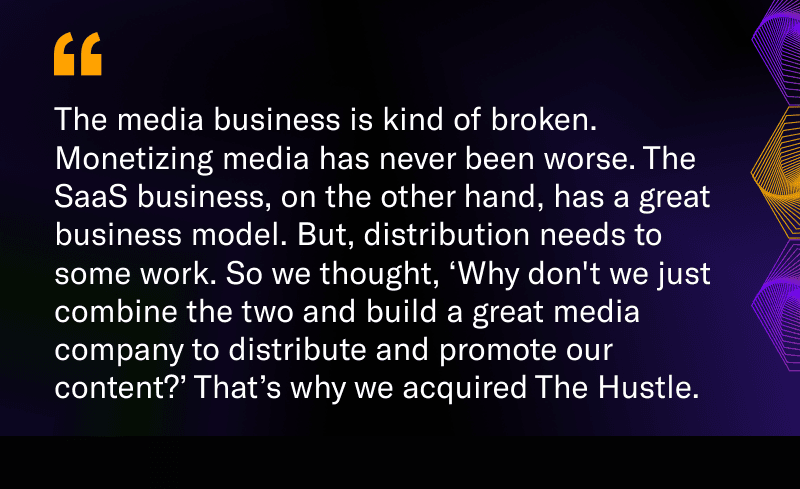The Secrets Behind HubSpot’s Marketing Success: Kipp Bodnar on CMO Diaries

Maximize Your Marketing ROI
Join 10,000 other marketers already getting the best tips on running engaging events that boost pipeline and create raving fans.
Welcome to our weekly CMO Diaries recap. This week’s guest needs no introduction (but we’ll give him one anyway 😀 ).
Kishore had the pleasure of chatting with Kipp Bodnar, Chief Marketing Officer at Hubspot. Kipp has been with HubSpot for over ten years and has seen the company grow from the early days of Inbound Marketing to become a full suite of tools and integrations for marketing, sales, content management, and customer service. Talk about an evolution!
For anyone that’s not familiar, HubSpot is a CRM platform that makes it easy for your entire company to work together — from marketing, to sales, to customer service. Their hubs are powerful alone, but even better when they’re paired together. More than just a software company, HubSpot has created an ecosystem uniting software, education, and community to help businesses grow better every day.
Kipp shared all of his B2B marketing secrets including how HubSpot thinks about social media, how HubSpot’s go-to-market strategy has changed as they’ve moved up-market, and the mindset behind marketing like a media company. This is truly an episode you don’t want to miss!

How does Hubspot think about social media?
Social media has become such an interesting channel over the past several years because it's become really diversified—and not just in platforms but also in media formats.
I think the number one key, whether you're a B2B company or a B2C company, is that you have to decide where you're going to play. You can't be everywhere. If you try to be everywhere, you're going to fail.
So for us, we decided we were going to play on Twitter, LinkedIn, and Instagram. Those are the places we were really going to be successful.

Step two is channel expertise, which actually matters. You have to have this balance of people who can tell great stories to your audience and folks with domain expertise. Stories are always, always going to matter. But as social media become more mature, having the domain expertise—not just of the algorithms and formats—but a true pulse on what’s happening in these platforms will amplify your efforts. The types of stories that are trending and driving engagement on different networks matter so much right now.
The third thing is to know why you're playing there. What are you trying to accomplish? Are you trying to drive high-level brand awareness? Are you trying to drive influence traffic? There's a whole host of ways of things that you could choose to move as a metric.
For us, we think of social media as a proxy for top-level metrics like brand awareness, brand sentiment, and audience growth versus more mid-funnel or lower-funnel metrics.
As HubSpot has matured and moved up-market, how has your go-to-market movement changed?
If you're moving up-market, no matter who you are, then your constraint is perception. Do people believe your product or service fits the level of sophistication, complexity, customization—whatever that is?
And if you exist down-market or you're moving down market, then your challenge is fundamentally distribution. How do you get in front of enough people at a low enough cost to make it work?
That's it. That's the whole ball game. Every company starts in one of those two places solving one of those two problems: perception or distribution.
For us, we started at the low end. We were going big on Inbound Marketing, which was new at the time, so low-cost distribution mattered a ton. But there's moving up-market, there’s moving down-market, and then there's having a go-to-market strategy that serves both modalities.
So, we did the latter. We care just as much about a 20 person company as we do a 2,000 person company. But that means we have to operate at both ends of that spectrum. How do we do that? I’ll give you two quick examples.
At the distribution level, we've got a podcast network where we've gotten over 8 million monthly downloads in just the past ten months. We’re making significant progress in growing our distribution network and global audience.
Then at the perception level, we just rolled out a fantastic brand campaign with Katherine Hahn. We're leading with this campaign globally, and it's having a tremendous impact at the perception level.
You have to just be clear—which one of those are you choosing, and do you have the right strategies and plays lined up to make the impact that’s needed for your company’s stage?
Whether you’re a startup, a mid-scale of company, a more enterprise company, the framework and the framing of the problem is always pretty similar.
👋 Psst! You can check out HubSpot’s flashy new brand ad below:
How does Hubspot approach content marketing? What’s working right now?
First of all, the first thing you have to understand is that before you even get into channels, you have to think about how much of your marketing is going to be programmatic versus campaign-driven.
I think about programmatic as evergreen content that will consistently drive audience, demand, signups, or leads. A campaign, on the other hand, is a point in time. You’ve got a new product or a new point of view to promote. Campaigns are constrained versus evergreen, which provides value long after launch.
Most of the businesses that fail have way too heavy of a campaign approach where they rely 60%-90% on campaigns, and they end up stuck on a hamster wheel. This model is really hard because you can never keep up with the compounding growth at scale.
Instead, I think you need a majority programmatic approach for any go-to-market efforts. Programmatic channels are search engine optimization, email marketing (especially if you're relying heavily on automation), referral traffic, affiliate programs, etc.

We have a rule in marketing at HubSpot that we stick to, which is you do not make anything until you know how it's getting into the world. That is the first principle. You don't make something and then figure out how to market it; how you're going to market it determines what you're going to make—and that small flip matters a ton.
The way that we think about it is if we create blogs to get traffic from Google, that’s great. Then Google's how we distribute this content. That's awesome.
Well, then who's our audience. What do they care about? We need the right insights into the right keywords and the subjects we’re writing about. What are the topics that really matter most to that audience?
And then from there, you have to put that content through a creative process that then takes that topic and provides the best, most thorough answer and education information on that topic that can exist online.
And if you can bring these things together—I don't care if you're a one-person marketing organization—if you do that for even a few posts a month, it’s going to make a difference.
This approach works because you've got alignment on your story and your distribution. You're really clear on what you're doing and what you're making. And, you're making something that is so valuable to the end consumer that is going to resonate in the market, get inbound links, and eventually like help scale the audience that's coming to your site month after month.
“Marketing like a media company” is a big trend in B2B marketing right now. Can you tell us about the strategy behind “The Hustle” acquisition?
\For those who don’t know, HubSpot bought a media company called The Hustle in February of 2021. We got a daily email newsletter, a podcast called My First Million, and a subscription community called Trends.
We looked at it, and we thought—the media business is kind of broken. Monetizing media has never been worse. The SaaS business, on the other hand, has a great business model. But, distribution needs to some work to be more effective. Then we thought, why don't we just combine the two and build a great media company, but instead of selling ads we just promote and re-distrubute our content? So, that's what we did.
It actually started with this incredibly simple chart that was a side-by-side list of the different ways our audience wants to interact with us and where we currently distribute our content.
We listed things like our text-based content, YouTube videos, podcasts, email newsletters, etc.
And we said, where do we play? Where do we have really good coverage, and where are we lacking?

Through this simple exercise, we realized that we didn’t have a great daily email newsletter and we weren’t where we needed to be on podcasts. That’s where The Hustle came into play as a way for us to close those gaps.
We've got over two million people subscribed to The Hustle daily email newsletter. We took My First Million and made it a top 10 business podcast in the world. We also used the show to anchor our podcast network, which didn't exist on May 1st of last year. And again, we did 8 million downloads last month. We were able to really grow orders of magnitude in a pretty quick time period.
Acquisitions and partnerships like this can be really effective if you feel like you have real gaps and you can accelerate the time to getting value and creating value for your customers.
Do you have any book recommendations?
Right now, I'm reading on the I'm reading Harlem Shuffle by Colton Whitehead on the non-fiction side. I’m also reading
I'm reading The Power Law, which is an venture capital investing book, and Principles by Ray Dalio.
It’s funny—people always ask about books, and yes, books are awesome. But my biggest advice to anybody is to think about the one thing you wish you knew a lot about. Try to talk to the 10 people in the world that are the best at that one thing. If you are really genuine and flattering, most people give you 30 minutes their time.
—
Wow! So much good insight in this episode. Thanks for joining, Kipp! We’ll see you next week for another episode of CMO Diaries.

Stay In Touch
Platform
Resources
Company
Community
© 2025 Copyright Goldcast, Inc. All rights reserved.



 Upcoming Events
Upcoming Events Event Series
Event Series On-Demand Events
On-Demand Events

